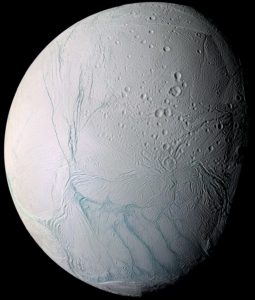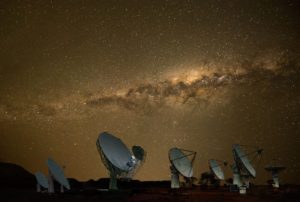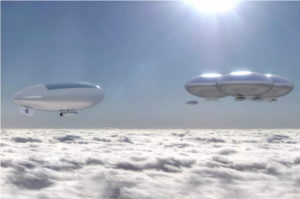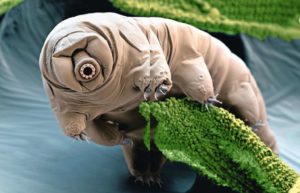Radio-Astronomy
I developed a certain interest in radio-astronomy since my master in Orléans and the multiple visits to the Nançay radio-observatory. I find the concept of combining dozens or hundreds of antennas together thanks to interferometry is very amazing, and also elegant given it is simple in concept, and yet, still challenging in application. I was lucky enough to visit a couple of radio-observatories so far: Nançay, Effelsberg, ALMA, and Jodrell Bank, and I would gladly visit more as I’m also happy to always learn more on the technical aspects of radio-astronomy.
Of particular interest to me is the project SKA. SKA, or Square Kilometre Array, when achieved to its full extent, will be a collection of thousands of antennas in South Africa and Australia deserts, spawned over several kilometres to obtain thanks to interferometry, an equivalent-size telescope.
It is a tremendous effort in its collaboration and technical aspects: construction challenges, enough fibre optics to wrap twice around the Earth, more data generated than the global internet traffic, etc. But on top of that, the SKA project is also linked to development program for South Africa and Africa in general.
Because of those reasons and many others, this project is one of the most inspirational effort I know of.
If you would like to know more about SKA, please visit their website.
Solar System Exploration
The exploration of the solar system is of course a topic of deep interest for me given it lies so close to us, and yet so far away and still so hardly accessible! Of particular interest to me are Enceladus and Venus.
Venus
« Mars n’a rien de curieux que je sache […] Mars ne vaut pas trop la peine qu’on s’y arrête. »
« Mars has nothing of curious as far as I know […] Mars does not deserve we spend time on it »
(De Fontenelle 1686; Entretien sur la pluralité des mondes)
Even though De Fontenelle lived centuries ago, and knowledge of the red planet has progressed since then, he would still probably feel the same about Mars. Indeed, it does not present any particular higher scientific interest than any other body of the solar system, yet, it is the center of the attention of the solar system exploration, because it is the easiest place were to go out of the Earth orbit. Or is it? Venus is a strong candidate too! With a shorter distance at more frequent interval, it would actually be easier to go to Venus. Landing on Venus though, would expose you to an intense pressure of 93 bar, the same that you would feel going at 900meters of depth in the oceans of the Earth, some « nice » acidic atmosphere, and a temperature of almost 500ºC! Really the problem with Venus is not to go there, but survive there! On that point Mars is much better. But is the surface the only interest place to explore on Venus? Far from it, thanks to its very thick atmosphere. The second planet of the solar system would also have huge advantages in comparison to Mars: closer to the sun, solar panel would be much more efficient, even more efficient than on Earth. The atmosphere and magnetosphere of the planet would also protect from the sun and interstellar radiations. In facts, exploring Venus, with a crewed mission, via its atmosphere is exactly the goal of the HAVOC project, standing for High Altitude Venus Operational Concept. Although not mature technologically, it is a concept I am closely watching and hope to see tested in the coming decades.
If you need one element to sell you this mission: they use blimps! Zeppelins are such elegant and iconic vehicle that I hope to see back in business on Earth in the future given their many advantages and nowadays highly improved safety! The concept of HAVOC is thus simple: bring blimps able to stay at high altitude in the atmosphere of Venus, in order to create a base able to welcome a manned mission crew for a few months in order to study the atmosphere of Venus. Aiming for a 55km altitude would enable a temperature, pressure and gravity similar to that of Earth. This altitude should also be mostly free of acid clouds, although it would still present many challenges. In addition, if in the past Venus was thought to be literally hell and enable to bare any life, recent discoveries of airborne organisms high the atmosphere of the Earth brings back the hypothesis that similar bacteria and microscopic organisms could also thrives in the upper atmosphere of Venus, making it an even closer contestant to Mars in terms of scientific interest.
Enceladus
 Enceladus is one of the satellites or « moons » of the planet Saturn. It is my favourite celestial body in the system for a simple and very subjective reason: I find this moon very beautiful. But it does not stop there! Similarly to Europe, a satellite of Jupiter, Enceladus is most probably composed of a solid rocky and metallic core in the middle, surrounded by a thick shell of water. Being so far from the Sun, the temperature is so cold there that the surface is completely frozen. Yet… the story does not end there! Indeed, it is believe that only the outer part of the water is frozen, creating a very thick ice crust, surrounding an ocean of liquid water trapped between the core and the ice shell. This is likely due to friction and heating created by the tidal forces induces by their parent giant planets. The « tiger stripes » visible at the surface in light blue on the picture to the left, would be due to those tidal forces, breaking the kilometers deep ice layer and allowing some of the liquid water to escape to the surface. It would also escape by the mean of cryo-volcanoes, where basically lava is replaced by water and volcanic rock by ice.
Enceladus is one of the satellites or « moons » of the planet Saturn. It is my favourite celestial body in the system for a simple and very subjective reason: I find this moon very beautiful. But it does not stop there! Similarly to Europe, a satellite of Jupiter, Enceladus is most probably composed of a solid rocky and metallic core in the middle, surrounded by a thick shell of water. Being so far from the Sun, the temperature is so cold there that the surface is completely frozen. Yet… the story does not end there! Indeed, it is believe that only the outer part of the water is frozen, creating a very thick ice crust, surrounding an ocean of liquid water trapped between the core and the ice shell. This is likely due to friction and heating created by the tidal forces induces by their parent giant planets. The « tiger stripes » visible at the surface in light blue on the picture to the left, would be due to those tidal forces, breaking the kilometers deep ice layer and allowing some of the liquid water to escape to the surface. It would also escape by the mean of cryo-volcanoes, where basically lava is replaced by water and volcanic rock by ice.
Finally, one of the most intriguing fact about Enceladus is the possibility to get underwater volcanoes at the boundary layer between the rocky core and the ocean. This could potentially lead to condition very similar to what is supposed to have been the place where life appeared on Earth… Thus, Enceladus might be the place in the solar system with the best chance of finding life out of the Earth: a life hidden under several kilometers of ice, in an sub-surface ocean where the light of the Sun never shines. As the Sun is an element, often forgotten in our modern life, yet with so much impact on the organisation of our society, on religious beliefs, etc. I particularly enjoy the thought experiment of imagining how the absence of the Sun could have impacted an intelligent life form which would have appear in such an environment that is the Enceladus ocean, and their society: from the way time is perceived to the religious beliefs, passing by the comprehension of the universe…
Extremophiles and tardigrades (and deep sea exploration)
Extremophiles are organisms able to withstands living conditions deemed so extreme that it is a real surprise they are able to survive there. It might be temperatures (cold or warm), pressures (or vacuum), salinity, acidity, radiation levels or even specific highly toxic chemicals that they are living in. This unique abilities possessed by the extremophiles organisms is challenging our notions of favorable conditions for life, and push us to search for life in a more diverse way, as well as to broaden our definition of the habitability of a planet, making for me a topic of interest to any astrophysicist specialised in exoplanets. Most extremophiles are bacterias or very simple organisms, although more complicated ones also exist. A famous example are all the creatures living deep in the oceans, sometimes even lower than 8000m depth. For this reason, I also have a close interest in deep sea exploration.
The undisputed rulers of this category, and my all-time favourites, are the tardigrades, sometime also called waterbears. They are marvels of the evolution, and have conquered every type of biomes on Earth, from the hot springs of the Himalaya to at least 4000 metres deep in the oceans. That being said, they do have a strong preference for wet and humid environments, particularly mosses. They are tiny creatures of 0.1 to 1.5 mm, able to live up to 2 years. There are over 1200 different species and many are known to be able to survive some of the following conditions although none is able to survive all of them. In many of the the following conditions, they actually do not actively live, entering a state of cryptobiosis enabling them later come back to life once conditions are more favorable. This cryptobiosis means their metabolism slows down below 0.01% of its usual activity, while their body reduces its water content to less than 1%. This process has been shown to enable a return to a normal life, up to 30 years later at least. Tardigrades can withstand:
- Freezing temperatures. Tardigrades have been found to survive to temperatures of less than 1K (for a few minutes only, but it can be years at -50ºC)
- Boiling temperatures up to 150ºC
- Pressure up to 6000 atmospheres, more than at the deepest point of the Earth ocean.
- Dehydration. As pointed out, during their cryptobiosis they reduce the water content of their body which is otherwise of 85%.
- A full range of toxins such as sulfur.
- Radiation. Probably their second most impressive feature. They can survive 1000 times the lethal dose of radiation for the human beings, making them the living beings the most resistant to radiations.
- Finally, surely the most impressive feature: they are the only ones known to date to resist to outer space for at least 10 days.


